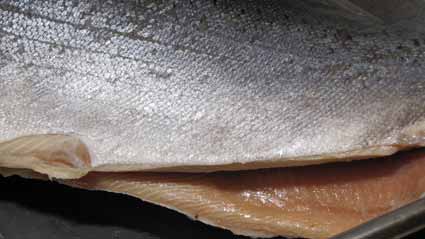Editor’s note: This post has been modified from an earlier version for purposes of clarity and conciseness.
How do you change human behavior, a difficult proposition in itself, let alone when a big problem is largely invisible to the public eye?
When it comes to the problem of overfishing, Lyf Gildersleeve of Flying Fish Company, a sustainable seafood buyer and retailer, sees education as the key. As we see in this video, there are varieties of non-targeted, commercially caught (bycatch) fish, that are not generally known to the eater. By establishing a commercial demand for these “trash fish“, it would help reduce the demand pressures on the most popular ocean fish that are being overharvested.
Gildersleeve shows 3 of the 4 “trash fish”: Ivory King Salmon, Pacific Skate, Wolf Eel, and Sanddabs (not pictured in this video) that will be used for a Portland Chefs Collaborative fundraiser event to raise public awareness of overfishing. At the dinner (video coming next Tuesday), guests taste a variety of “trash fish” dishes prepared by 4 renowned restaurant chefs, to demonstrate how each fish can look appealing on a plate, and also be delicious to eat.

As once a commercial fisherman himself, Mr. Gildersleeve understands the economic pressures small commercial fisherman face. If more eaters become aware of these lesser known fish, adding additional species of fish to the commercial mix can also help strengthen the viability of these fisherman who rely upon the local marine environment to provide for their economic sustenance.
We have long been advised to eat more fish; perhaps it’s time, to eat more kinds of fish, too.
These are the 10 most consumed fish species, in order of quantities consumed*
- Shrimp
- Canned Tuna
- Salmon
- Tilapia
- Pollock
- Pangasius
- Crab
- Cod
- Catfish
- Clams
*National Marine Fisheries Service; 2012 figures.
Additional Resources:
- The Monterey Aquarium Seafood Watch Program Buyer’s Guide offers a comprehensive list of commercially available fish species to avoid eating entirely, along with a list of more sustainable alternatives.
Video Transcript:
Lyf: Definitely a little bit different.
Fred: What’s that called again?
Lyf: This one’s the Wolf Eel. Oh, look at that – that’s a tooth!
To me trash fish are-are gonna be more/a-a less desirable fish that the fisherman catches but it’s not the target species that they’re gettin’ the most amount a money for on the docks.
My intention with-with helping to promote and source the fish and you know bring more awareness to trash fish is to make people recognize that there’s more than just tuna, salmon and cod and, you know, shrimp out in the ocean. And it’s to be able to get the fishermen more money for the entire catch, not just for the target species that they’re after.Lyf: This is the Ivory King Salmon
From the outside an Ivory King salmon is exactly the same.Rebecca: So when do you know it’s a white?
Lyf: So that’s the deal is you don’t know. I mean, literally you catch this fish on-on the boat and you do not know whether it’s a-a white King salmon or a red King salmon until you gut it and then you can open up this belly cavity and see that it’s either red or that it’s white.
Rebecca: Once a fisherman guts one of the King’s and sees it’s a white, what does he do with it then?
Lyf: Well, they just have to set it aside in a different bin and-and they sell it to the processor for half the price. So they’re happy that they just caught a fish but then they see that it’s Ivory and they say, ‘Damn, I just made half the amount a money that you know the red King is gonna bring me’ so it’s a less desirable species.
Most scientific research shows that this actually has an extra enzyme that breaks down the color, the carotenes, and it does not store the carotenes in its cells. It actually assimilates the carotenes and just utilizes them as nutrients and then it doesn’t store it in a cell. So that to me is the more realistic answer as to why they’re white. It’s kinda like an albino animal.
It has an amazing flavor to it but people don’t know about it. So they, the fishermen don’t get as much money at the docks for it.Lyf: So skate is a stingray. The center body of the skate basically got cut out and then those are the skate wings. Really nice fish. The skate wing is a kind of delicate texture. People aren’t out asking for skate wing – – and they’re not asking to eat stingray, you know per se and so-so, yeah, bringing more awareness that you know it’s just as good of a fish as the sole.
Lyf: If he can sell all the species that he’s catching then he’ll have to go out and fish less because he’s selling the whole, the whole line of species rather than just selling off you know the black cod or the soles that are worth a/the money and then the rest of the fish aren’t worth anything. So he has to go back out again to get more of the sole that are worth something. Let’s get these fish worth something so that it feeds more people, less pressure on the ocean because the full catch is getting eaten rather than just the target species.
Most of the videos featured on Cooking Up a Story were produced, filmed, and edited by Rebecca Gerendasy. Fred Gerendasy contributed as a writer to many of the posts and occasionally as the interviewer. Visit Rebecca Gerendasy Clay – Art and Fred Gerendasy Photography to see their current work.

